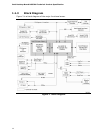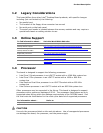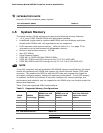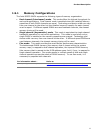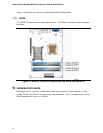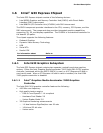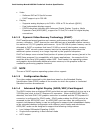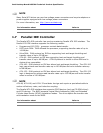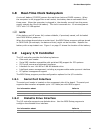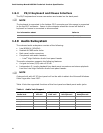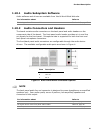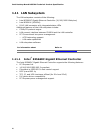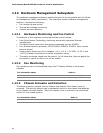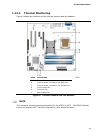
Intel Desktop Board DG33BU Technical Product Specification
22
NOTE
Many Serial ATA drives use new low-voltage power connectors and require adapters or
power supplies equipped with low-voltage power connectors.
For more information, see: http://www.serialata.org/
For information about Refer to
The location of the Serial ATA connectors Figure 10, page 42
1.7 Parallel IDE Controller
The Parallel ATA IDE controller has one bus-mastering Parallel ATA IDE interface. The
Parallel ATA IDE interface supports the following modes:
• Programmed I/O (PIO): processor controls data transfer.
• 8237-style DMA: DMA offloads the processor, supporting transfer rates of up to
16 MB/sec.
• Ultra DMA: DMA protocol on IDE bus supporting host and target throttling and
transfer rates of up to 33 MB/sec.
• ATA-66: DMA protocol on IDE bus supporting host and target throttling and
transfer rates of up to 66 MB/sec. ATA-66 protocol is similar to Ultra DMA and is
device driver compatible.
• ATA-100: DMA protocol on IDE bus allows host and target throttling. The ATA-100
logic can achieve read transfer rates up to 100 MB/sec and write transfer rates up
to 88 MB/sec.
• ATA-133: DMA protocol on IDE bus allows host and target throttling. The ATA-133
logic is designed to achieve read transfer rates up to 133 MB/sec and write transfer
rates in excess of 100 MB/sec.
NOTE
ATA-66, ATA-100, and ATA-133 are faster timings and require a specialized cable to
reduce reflections, noise, and inductive coupling.
The Parallel ATA IDE interface also supports ATAPI devices (such as CD-ROM drives)
and ATA devices. The BIOS supports Logical Block Addressing (LBA) and Extended
Cylinder Head Sector (ECHS) translation modes. The drive reports the transfer rate
and translation mode to the BIOS.
For information about Refer to
The location of the Parallel ATA IDE connector Figure 10, page 42



